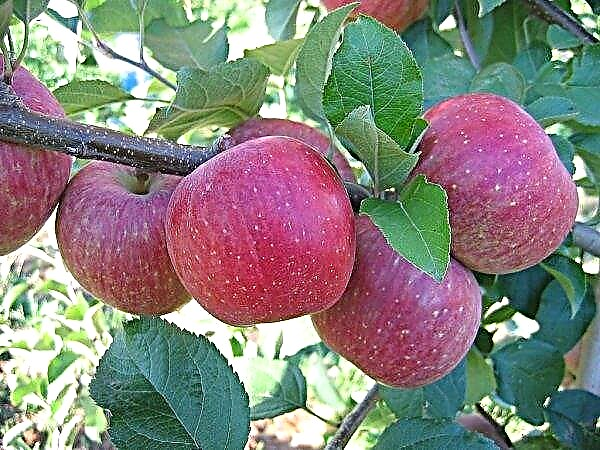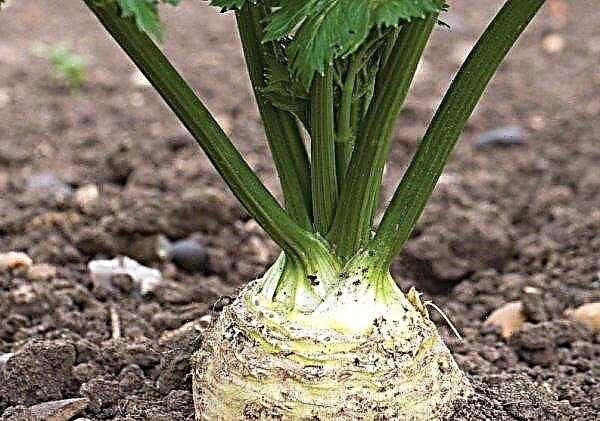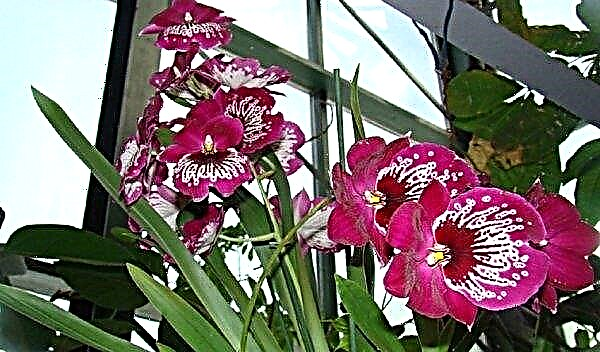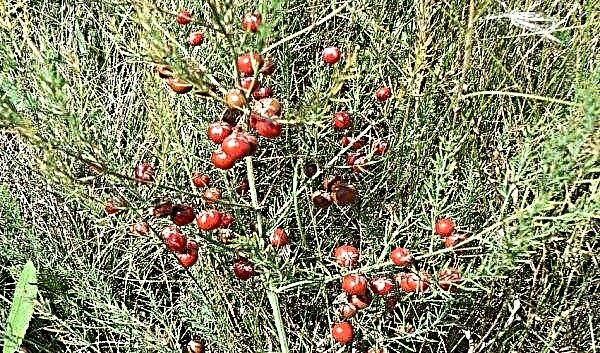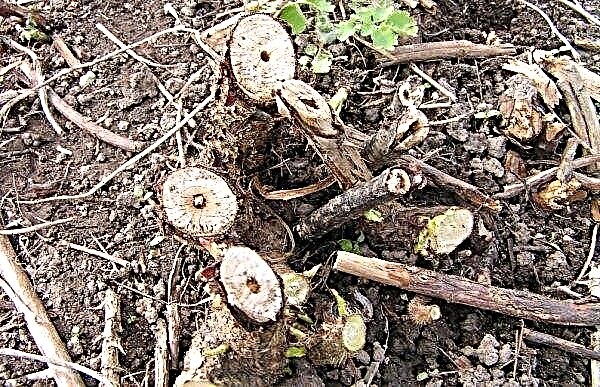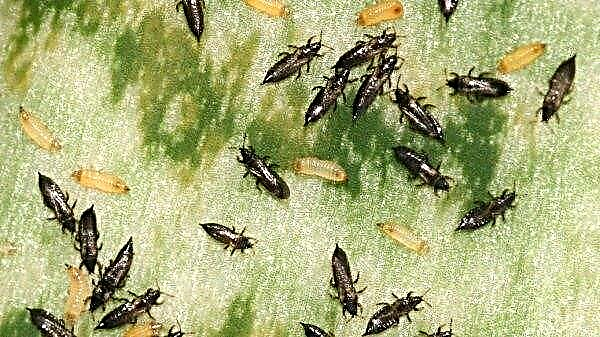The Dutch Indigoletta rose variety is today one of the most unusual and elegant varieties of climbing roses in the garden group due to its unique color and other botanical features. It is the last aspects, as well as the rules for caring for this purple beauty, that we will consider in our material.
History and botanical features
Rose Indigoletta (Rose Indigoletta) appeared in 1981 in the town of Lottum in the Dutch province of Limburg thanks to the original work of the famous Dutch scientist named Van De Laak. According to scientific data, the official name of the flower sounds like Azubis, and among the gardener-collectors you can find more exquisite names, for example, the Blue Lady (Blue Lady) or the Blue Queen (Blue Queen).
The botanical features of Indigoletta rose varieties are as follows:Important! The fan-shaped arrangement of the branches of the plant stimulates the flowering of Indigoletta not only in the upper, but also in the lower part of the wall, facade or fence. On the columns, the lashes are twisted in a spiral way.
- the corolla of the flower protecting pestles and stamens has a lilac color with a pink or blue with a lilac hue, in contrast to the buds that have not yet blossomed, which have a deep purple color and resemble glasses in their form;
- According to its characteristics, Indigoletta plumata belongs to klimmers, or klimings (large-flowered plants) - voluminous flowers reach a diameter of 8–10 cm, and the number of petals with a terry-silky surface ranges from 25–30 pcs.;
- the nature of the arrangement of buds on the stem is group-shaped, 2-3 inflorescences, while one inflorescence contains 2-3 flowers;
- thickness and height of plants (up to 2.5–3 m), strong root system;
- high level of growth and density (maximum bush volume - 150 cm);
- dense foliage having a glossy surface and a pleasant dark green color;
- high reliability of the stems and the strength of climbing branches, characterized by straightness, which are quite difficult to bend when sheltering the culture for wintering.
Rosa Indigoletta is famous for the widespread pleasant aroma of flowers, which is made possible to feel twice a year, since the variety is re-flowering. The first period of long and abundant flowering of the climbing beauty coincides with the end of spring - the beginning of summer, and the second - with the end of summer - the beginning of autumn. Indigoletta is said to emit a scent similar to that of Damascus rose.
How to choose seedlings when buying
When choosing plant seedlings, it is necessary to consider what they should be:
- strong;
- without wrinkling and spots, stripes, browned areas;
- with sleeping kidneys;
- without green shoots.
In the case of acquiring a leafy seedling with an open character of the root system, pay attention to the development of the latter and the absence of pale leaves. If the seedling is grafted, then it should have 2-3 perfectly ripened and already lignified processes with green bark, and the root system should have many thin and healthy roots. There can be no fracture at the vaccination site.Did you know? Natural rose oil is one of the most expensive essential oils in the world, as approximately 3 tons of flower petals must be processed to obtain 1 liter of consistency.
The best places to sell plant seedlings are greenhouses or specialty stores, and you can often buy the wrong variety on the market.
How to plant on your site
In planting roses, like any plant, there are specific steps that should be followed: we will consider them below.
The timing
As practice shows, roses of this variety are planted in 1-2 months of autumn after preliminary placement of seedlings in water for a couple of hours. But it will be great if you manage to purchase and plant Indigoletta seedlings in the spring, when the ground is already well warmed up.
Site selection and preparation
- Lighting. The described variety of roses loves well-lit areas, but at the same time excluding direct sunlight, that is, partial shade, on the plant (contrary to the general rule for members of the Rosaceous family Rosehip).
- Windiness. A through flow of air and stagnation of the latter should be avoided, with mandatory protection of the site on the north side.
- The soil. Planting should be carried out in an optimally fertile soil, characterized by a normal level of air and water permeability (well-drained) - loam is most suitable for this purpose and this plant.
- Before planting, it is necessary to weed the soil in order to remove weeds. Digging the soil is done for a more even and intensive fertilizing of the soil with organic (manure, peat, compost, etc.) and phosphate (bone meal, etc.) fertilizers. In addition, pure cultures of soil bacteria have proven themselves well as a pre-plant feeding of rosaceae.
Landing pattern
The optimal distance between seedlings on open ground is from 50 cm to 1 m, and between rows - from 1 to 2 m. In the case when Indigoletta is grown near the fence, at least one and a half meters should be retreated from the latter. The order of planting is staggered, in order to avoid subsequent shading of the plants with each other.
The parameters of the pit for planting should be proportional to the roots of the seedling in an unbent position: on average it is 30 × 30 × 40 cm. It is important that the root collar must be covered with soil.
After placing the seedling, the following steps should be taken:
- Gently sprinkle the bottom of the plant with soil.
- Water the plant abundantly (at least 1 liter of water per 1 bush).
- Loosen the soil after the latter has completely absorbed the liquid.
- Form a swirling earthen roller about 10 m high. Such a construction will help to avoid the spreading of water during the watering of the rose.

Care Tips
The main procedures for caring for the climbing culture are as follows:
- systematic watering;
- soil loosening, weed harvesting;
- pruning, fertilizing fertilizers;
- implementation of a garter if necessary.
Consider each of the steps for caring for the climbing plant separately and in more detail.
Did you know? The fortieth head of the United States of America, Ronald Reagan, with his resolution, secured the status of the state flower symbol for the rose. In addition, this flower is also a national symbol in the UK and Iran.
Watering
To root the plant, it is necessary to water the plant for the first month with a frequency of 1-2 times in 7 days and with a minimum calculation of 1 bucket of water per 1 bush. In the event that the weather conditions are hot enough, it is possible to irrigate 3 times in 7 days, while consuming a larger volume of water, for example, 1.5–2 buckets. Subsequent watering of Indigoletta is necessary as required, since overflow can lead to the process of rotting of the roots and death of the plant.
When caring for a rose, you cannot use watering with a hose: she does not like surface irrigation. It is better to water each bush with a bucket of water or purchase a special deep watering can.

Top dressing
As a fertilizer, plants can use ordinary manure. In early spring, fertilizing with a complex of fertilizers containing nitrogen, potassium and phosphorus will be necessary. In summer, immediately after flowering, potassium-phosphorus aggregate with a minimum amount of nitrogen is most suitable. At the end of summer, nitrogen top dressing is removed altogether: roses require more potassium during this period.
By the way, before each stage of flowering, it is desirable to spray the plants using a boron microcomplex.
Important! Be careful with nitrogen fertilizers, which in excessive quantities negatively affect the formation of flowers, thereby stimulating an increase in the leafy part of the plant and a decrease in the intensity of nutrition of the flower part.
Loosening and weed control
Loosening of the soil must be carried out after each of its moistening, including natural due to rain. Weeds are harvested as needed.
Pruning
Pruning of old, shrunken and diseased, as well as exceeding the support length of lashes and shoots is done in spring and autumn: only young, strongest and longest shoots should remain on the stem of the plant (their optimal number is from 1 to 3 annual and about 3–7 main flowering shoots). During flowering, it is also necessary to remove already faded specimens.
Support
Garter of the rose is performed when the plant reaches a very significant height - when it can no longer be independently upright. It is recommended that you tie it to a support or a trellis structure using a solid twine or a plastic clamp. At the same time, it is worth paying attention that the horizontally directed process is characterized by more abundant flowering.
Did you know? The status of the record holder for the largest size among roses belongs to the Lady Banks Roses variety: the circumference of the main stem of the plant reaches 3.7 m, its height is about 2.7 m, and its life span is already 120 years. You can see her in the state of Arizona (USA).
Protection against diseases and pests
The Indigoletta rose variety is characterized by medium resistance to such a common disease among plants as powdery mildew.
Signs:
- a bluish-gray coating on the foliage, gradually turning into a black fungus;
- moisture loss and, as a result, drying of leaves and buds.
Treatment for damage:
- Cutting of absolutely all diseased shoots, cleaning and burning of affected leaves and buds.
- Spraying with fungicides “Fitosporin-M”, “Planriz”, “Gamair” or “Alirin-M”.

The root cause of the defeat of the plant by such a fungal ailment as black spottingis a combination of rainy weather and warm temperature.
Signs:
- the formation of brown and black spots on the foliage with a clear yellow border;
- over time, the formation of a spot of tuberosity from a spore of the fungus in place.
- watering the plant exclusively at the root;
- timely cleaning of fallen dry leaves.
Treatment:
- treatment with biofungicides containing mancozeb (Ridomil Gold or Profit), as well as penconazole or triazole (Topaz or Skor);
- in summer, black spotting is treated by spraying the bush with Bordeaux liquid.

Shelter for the winter
The described variety has relatively good winter hardiness if grown in a temperate climate and shelters for the winter — the bush is able to withstand minus temperatures of –15 ° C, and in the summer season it is not particularly demanding in relation to the temperature indicators of the atmosphere. In harsh climatic conditions, the plant suffers and dies.
Preparing for wintering is as follows:
- cessation of irrigation and loosening of the soil;
- wrapping a bush with a tourniquet or two, with a tight but neatly pressed to the ground.
Shelter itself is produced already upon the occurrence of stable frosts using spruce branches and covering material. If you do this earlier, you run the risk of debating and decaying the culture. At the base of the plant, it is recommended to make an earthen cushion 30 cm high, and on top of it also fill it with sand or other mulched material.Important! The level of resistance to rainy weather in Indigoletta is average: the shape of flower buds, as well as already opened flowers, does not deform even under the influence of heavy showers. However, in rainy weather, it is still better to shelter the rose to avoid exceeding the soil moisture level.

What to do if it does not bloom
The reasons for the lack of flowering Indigoletta:
- poorly selected territory for cultivation;
- rigidity and lack of saturation with soil fertilizers;
- an excess of top dressing of a certain type, for example, nitrogen;
- the presence of weeds and wild shoots in the basal zone of culture;
- damage to plants by diseases or pests.
Having determined the cause, you must make every effort to fix it as soon as possible, minimizing the risk to plant health.
Breeding
The procedure is carried out by cuttings - the best option would be green cuttings, which are provided possible to get in early summer. If there are none, you can try to use the shoots that remained after trimming.
Reproduction Algorithm:- Cutting cuttings with 2 or 3 nodes.
- An incision under the lower kidney with an angle of 45 °.
- Removing excess foliage on the bottom of the stem.
- Planting cuttings in a container with a sand-earth mixture, subject to a depth of 1 cm (preferably in a shady area).
- Glass or film cover of the plant.
- Watering without removing the shelter.

Due to its botanical qualities and ease of care, as well as the unusual grace of weaving, the Dutch purple rose Indigoletta was chosen not only by flower growers-collectors, but also by landscape designers due to their frequent use of the latter to form various beautiful compositions. This plant looks luxurious as a decoration for both fences and garden arches, as well as house walls, a facade, as well as arbors.





